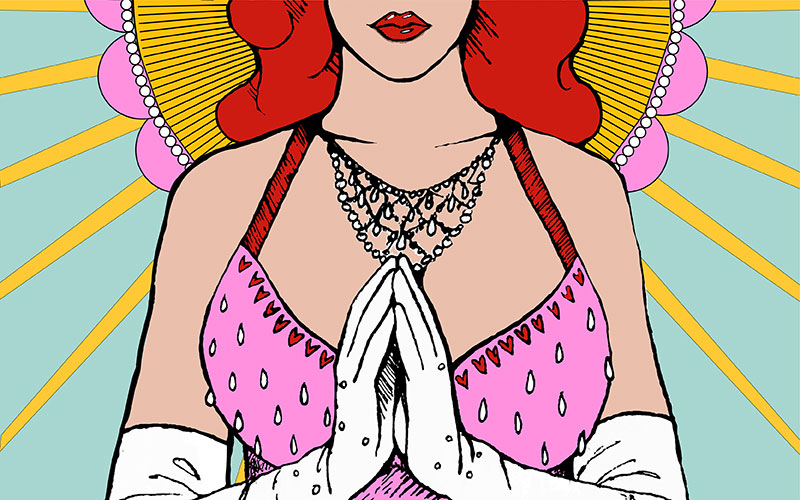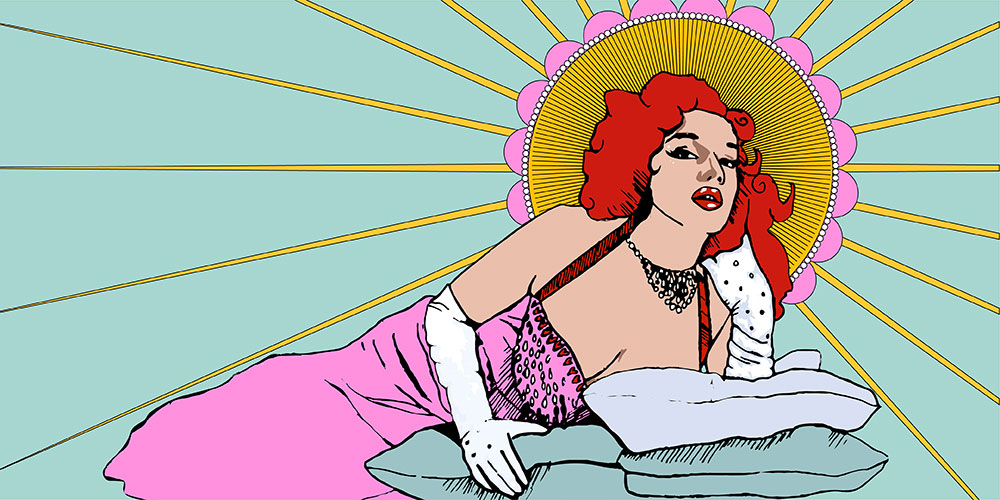Who was the United States’ preeminent “exotic dancer” in the middle decades of the 20th century? A controversial question, to be sure, about which people of discriminating taste have been known to express drastically opposed opinions. A recent edition of The Washington Post prominently displayed an obituary for Tempest Storm, an exotic dancer (read “stripper”) who was widely touted as the “Queen of Burlesque” during the 1950s and 1960s. Ms. Storm did, in fact, obtain considerable attention from the media during her heyday, as much because of her romantic liaisons — with Elvis and JFK among others — as because of her artistry on the stage. And, to judge by the fulsome obituary and accompanying photograph published in the Post, Tempest Storm’s reputation has endured to this day.
Regrettably, I never saw Tempest Storm perform, but I did have the privilege of observing — when I was 14 years old — a performance by her renowned contemporary and rival, the equally endowed and gifted Blaze Starr. And Blaze Starr, too, was as famous for her dalliances as for her lusty performances. So, after reading Tempest Storm’s obituary, I felt impelled to search for news of Blaze Starr; and I discovered, to my sorrow, that she too had passed away, in 2015 at the age of 83.
Blaze Starr, née Fannie Belle Fleming, had a long and illustrious career as an exotic dancer. For decades, she was truly a star performer in her chosen profession, and, like Tempest Storm, she garnered additional publicity by virtue (pun intended) of the notorious liaisons that she cultivated along the way. There was a long-term affair with the governor of Louisiana, Earl Long, and a very short-term affair with a newly elected congressman, JFK (yes, him again.) Blaze Starr did have one marriage to her credit, to a man with the improbable name of Carroll Glorioso. She could have, I suppose, decided to call herself Blaze Glorioso — wouldn’t that have been perfect? — but she remained Blaze Starr.
Blaze Starr and I went way back. During my high school years in Washington, D.C. — the early 1950s — a visit to the Gayety Theater in Baltimore was a rite of passage for post-pubertal boys. The Gayety Theater was a venerable burlesque house located on “The Block” in Baltimore, at a time when burlesque shows were no longer to be found in D.C. Almost every boy I knew in high school made a pilgrimage to that theater in Baltimore, preferably on a day when Blaze Starr was booked there. My own initiation occurred during my sophomore year, when I was 14 years old and traveled with several other boys, all slightly older than myself (including one who had a driver’s permit), to Baltimore. The ushers in the theater hardly bothered to glance at the fake IDs that we brought with us. Suffice it to say that the “show” that we witnessed at the Gayety Theater in 1952 — and which did feature Blaze Starr — can be easily surpassed nowadays by a casual stroll on the beach at Ocean City. And on the beach, we wouldn’t have to endure the tiresome baggy-pants comedians and jugglers who opened for the wondrous Blaze Starr. Never mind, we were more than gratified by our experience at the Gayety. For me, it indeed constituted a “dalliance” of sorts.
Now, fast forward 40 years. I am a practicing physician in Chevy Chase, Maryland, and my partner Marvin, in the office next door, has left his office door open while he chats with a female patient. I chance to walk past the opened doorway when Marvin sees me and calls out, “Elliot, do you have a minute? I’d like to introduce you to someone.” He is referring to the woman seated opposite him, who is middle-aged and very attractive, red-haired, wearing a smartly tailored suit and a strand of pearls. “Elliot,” says my partner, “let me introduce you to Ms. Fleming.” We shake hands. He then turns to the woman and says, “Dr. Wilner grew up in D.C. Perhaps he was present at one of your performances.” I look quizzically at Marvin, who then says to me, “Ms. Fleming’s stage name was Blaze Starr. Does that perhaps ring a bell?”
It takes me several seconds to collect my wits and retrieve a 40-year-old memory, and then I blurt out a starstruck question: “Blaze Starr? The Gayety Theater, Baltimore?” The elegantly dressed woman smiles graciously and nods her head affirmatively. Then, not able to restrain the urgent impulse that is surging from my amygdala upward to my frontal lobe, I add: “Of course I remember you, Ms. Starr. Do you remember me? Gayety Theater, fourth-row center, early May 1952?” Blaze Starr laughs lightheartedly and responds, “Yes, of course I remember you. But are you sure it was the fourth row? I seem to recall seeing you in the fifth row. And you haven’t changed a bit.”
My partner and Blaze Starr had evidently just concluded the medical consultation that had brought her to his office, and now they were just sitting and chatting about old times. Blaze suggested that I pull up a chair and join them, which I did. Marvin and Blaze were about the same age, in their early 60s. He had moved to D.C. as an adult, after finishing a neurology residency in Minneapolis, and he knew nothing about teenage boys’ pilgrimages to Baltimore and the Gayety Theater. But he did know about the Silver Slipper supper club in downtown D.C., where Blaze had been a headliner later in her career. The Silver Slipper and other such clubs in D.C. were by now also a distant memory, just like the burlesque houses. I lingered a few minutes in Marvin’s office, asking a few more awkward questions of Blaze, before I had to excuse myself and get on with my day.
When I later reflected on that conversation, what impressed me most was how charming, articulate, and thoughtful Blaze Starr was. And how successful she had been in her chosen line of work — which was entertainment — and how much harmless pleasure she had afforded countless numbers of schoolboys. By today’s theater and film standards, her type of entertainment could hardly be called pornographic. It would probably be called boring.

After meeting Blaze Starr in my partner’s office, I never again laid eyes on her. She had given her last performance several years prior to that meeting and had retired to a small town in West Virginia, not far from where she was born. But I was destined to have yet another encounter — albeit a posthumous encounter — with this remarkable woman. Several months ago, a friend of mine staged a lavish party (Covid-19 be damned!) to celebrate his and his wife’s 50th wedding anniversary. And for this nostalgic occasion, he hired a vintage rock-and-roll band based in Baltimore — known as The Hubcaps — for the purpose of creating a 70s ambiance in the party room. I had earlier shared with this friend the story of my adolescent hejira to the Gayety Theater in Baltimore, where I had first encountered Blaze Starr. And he, in turn, had related my story to the Hubcaps’ manager, a middle-aged woman named Janie.
It so happened that Janie, while growing up in Baltimore, had lived on the same street as Blaze Starr, just two houses down the block. Blaze, who never had children of her own, became very attached to Janie. She would wave from her front porch every morning when Janie was walking toward the school bus stop, and after school, she would invite the little girl into her house for milk and cookies. And Blaze’s affection for children extended beyond her relationship with Janie. On her free afternoons (which were every afternoon of the week except for Wednesday and Saturday, when she had matinee performances), she would regularly — and fearlessly — meander down some of the mean streets of Baltimore, venturing into impoverished and high-crime neighborhoods in search of children who seemed to be in distress. When she would meet up with such a child, she would bring him or her to her home and contact Child Protective Services for Baltimore City. That agency would then dispatch a social worker to investigate and render assistance to the child — and the social worker who would most often be dispatched to Blaze’s house was none other than Janie’s mother.
From Janie, I learned that her mother’s surname (and, of course, Janie’s maiden name) was the same as mine. It turned out that Janie and I were cousins. I had only a distant memory of having met a member of the Baltimore branch of our family during my childhood, but I had not connected with any Baltimore relative during the past 70 years. Now our families could reconnect — an incidental result of the long-ago acts of charity that Blaze Starr had performed on behalf of neglected and forlorn children on the streets of Baltimore.
Before parting from Janie at the end of the evening’s festivities, I asked her if she had any insight into what might have been Blaze’s motivation in reaching out to those kids on the street. The answer should not have come as a surprise: Blaze herself had grown up as a hungry, neglected, and abused child in a hardscrabble hamlet in West Virginia — and she never forgot her roots. Nor will I ever forget the charming Blaze Starr — who was known to many as an exotic dancer but, alas, known to only a few as a saint.•




